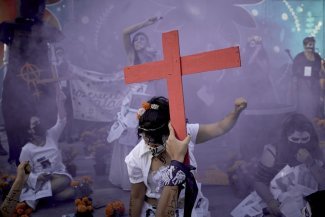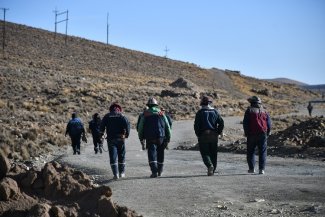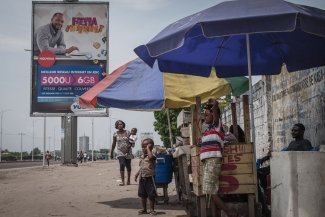The wine waiter in a smart restaurant in São Paulo, Brazil’s economic powerhouse, holds up a bottle for his customers.
He handles it as lovingly as a baby, then pours the wine into plastic cups. The pipes under the washbasins in the spotless toilets have been removed, so the water collects in bowls beneath and a notice asks customers to “please use this water to flush the toilets”.
In the past few months this city of superlatives – the richest, most densely populated, with the most cars – has seen many such oddities.
São Paulo has enjoyed the fastest economic growth of the past decade but now has a very severe water shortage.
With a population of 41 million, the state of São Paulo has been governed by the conservative Brazilian Social Democracy Party (PSDB) for the past 21 years.
Water supplies were already very low last year and in October, when the issue was raised during the final televised debate before the gubernatorial election, Geraldo Alckmin (PSDB) replied that “there is not, and will not be, a water shortage in São Paolo.”
He won the election. His quote is replayed endlessly on social media.
“At first, in August, they only cut the water off in the evenings but now they turn it off at noon,” says the restaurant owner, pointing to containers in the kitchen waiting to be filled when the water comes on.
“They” refers to Sabesp, a semi-public utility that handles water distribution and purification in São Paolo.
The rooftop water tank is insufficient so the evening’s dishes are stacked and washed next day.
Large bottles of drinking water are used for cooking; the extra cost is passed on to the customer.
Sabesp considered limiting supplies to two days a week in some neighbourhoods but had to give up the idea.
Its employees are concerned, since the company rarely communicates and has stopped giving interviews to the press.
Only under considerable public pressure did Sabesp start posting water cut-off times for each neighbourhood on its website, but they are often incorrect.
A 2014 documentary film, A Lei da Agua (The Law of Water) by André Vilela d’Elia was screened in São Paulo in January. When the lights went on the audience was silent.
The cinema was packed, as it is every time the film is shown, and the audience was eager for the debate with Ana Paula Fracalanza, a water management specialist at São Paulo University.
One audience member said water in her building is only turned on after 10 a.m, when she’s already left the house for work; elderly people in her building fill water bottles for those at work.
She asked: “Is there a Plan B for the months to come?” All eyes turned to Fracalanza, who said she knew no more than they did and had no idea whether there was a Plan B, C or D.
“What I do know,” she said, “is that the worst is yet to come.”
“Water is about human dignity”
Everyone is aware of the government’s Plan A, investing nearly US$315 million to harness water from the River Paraíba, which already supplies the neighbouring state of Rio de Janeiro.
The project means taking part of the state’s supply, and won’t be completed for 18 months at the earliest.
“We lost a lot of time because of the election. If the government had told us a year ago that we needed to save water, people would have understood,” said Marcelo Cardoso of the Alliance for Water, a network of environmental organisations established during the crisis.
Last October the water shortage in Itu, São Paulo, led to riots and people attacking public buildings.
The government sent water tankers with a police escort. The demonstrators were ordinary people, including many middle-class women.
“Water is about human dignity,” said Cardoso. “When people can no longer wash themselves or use the toilet or take care of their children, they start to panic.”
According to a report by the São Paulo state intelligence agency, printed in the Brazilian edition of El País, riots in the region could become as serious as those in June 2013, triggered by the rise in the cost of public transport.
Defesa.net (dedicated to security issues) claims the water crisis was the reason for sending São Paulo intelligence agents to the United States to train with Special Weapons and Tactics (SWAT) police units.
São Paulo acquired 14 riot vehicles last year, all with water cannons for dispersing crowds — but would the government dare use them against a protest about water shortages?
Proposals for optimising water resources abound. They include the development of agro-ecology; cleaning up the River Tietê, which has become an open sewer running through São Paulo state; repairing leaks in pipes (accounting for an estimated 25 per cent water loss) and capturing rainwater.
The government has not taken up any of them.
Deforestation
The reasons for the drought are to be found further north, in the parts of the Amazon rainforest cleared for cattle breeding and soya cultivation. Brazil’s agrifood industry, a pillar of its balance of trade, accounts for nearly 70 per cent of water consumption.
Exports of agricultural produce are the equivalent of an annual transfer abroad of some 112,000 billion litres of fresh water.
The sector is based on expectations of high annual rainfall, but deforestation — for agriculture — is jeopardising its expansion.
The forest not only helps to retain water in the earth but releases a considerable amount of vapour through earth and leaf transpiration.
Scientists estimate that the Amazon basin releases 20,000 billion litres of water a day and this humidity contributes to cloud condensation, provoking ‘flying rivers’ of aerial vapour.
“Winds from the ocean fill up with the vapour, and being blocked by the Andes, the water is sent to the south of the continent,” said, a climate specialist who has published a summary of 200 scientific reports on the Amazon.
Thanks to the Amazon ecosystem and the Andes cordillera, southernmost Latin America suffers less from drought than elsewhere at the same latitudes (the Namibian and Australian deserts).
The rains they provide are crucial to the production of 70 per cent of the region’s wealth.
“About 90 per cent of the Atlantic forest has been cleared, all along the east coast of the country, but we don’t feel the consequences of that because until now the Amazon has provided enough humidity,” said Nobre.
“But now 18 per cent of the Amazon is deforested and 29 per cent is damaged. We can’t pinpoint when exactly we’ll feel the effects of that disaster but we have been warning people for the past decade.”
According to the most recent estimates, 762,979 sq km of rainforest has been destroyed over the past 40 years, an area more than twice the size of Germany.
In 2004, 27,772 sq km disappeared. Although the annual deforestation rate was reduced to 4571 sq km in 2012, the respite was short-lived.
Under pressure from ‘ruralist’ deputies and senators defending the interests of the agrifood industry, the government amended its Forest Code in December 2011.
The new code considerably reduces the protected conservation areas and cancels all legal proceedings relating to deforestation, leaving the road clear for further damage.
The lack of rain has also led to electricity shortages in a country where 75 per cent of power plants are hydraulic.
Eduardo Braga, minister of mines and energy, has reiterated the government’s intention to build a dam on the River Tapajos in the Amazon, even though the Belo Monte dam on the River Xingu is not yet operational.
“Money, like water, is in short supply”
Will this drought in São Paulo revive awareness of the need to protect the Amazon?
For now, the federal government is focused on financing its Plan A for São Paulo, but it also has to deal with difficulties in other crisis states such as Rio de Janeiro and Minas Gérais, as well as farmers’ demands for drought aid, and industry’s requests for tax rebates on purchases of less water-intensive machinery.
The federal government has been caught unawared on too many fronts. Money, like water, is in short supply.
In the vast Vila Brasilândia favela, an hour’s bus ride north of São Paulo, the inhabitants are well aware of the water shortage.
At the base of the shantytown, water is cut off only as often as in the city, but the higher you climb, the less water there is.
A woman was saving the water from her washing machine: “I can wash the whole house with this.”
She was surprised to learn that the daily newspaper Folha de São Paulo published advice that includes recovering water from washing machines, putting a bucket in the shower, turning off the tap when brushing teeth.
“The people down in the town too, eh?” she said. “In that case it must be serious.”
From her laje (flat roof), we saw a multitude of containers on all the neighbouring roofs.
“Whenever it rains we put up tarpaulins with buckets at the corners,” said her son.
This works, but it has consequences in a tropical country. According to the city’s health department, cases of dengue fever this January were up threefold on January 2014.
A spectacular effect of the drought can be seen in the Cantareira reservoir system, one of the largest water retention systems in the world.
It is only eight per cent full and the landscape is desolate. The vast artificial lake now resembles an opencast mine and the earth around is cracked by the sun.
Francisco de Araújo, from the municipality of Bragança Paulista’s environment department, said: “No one seems to know what needs to happen for us to return to pre-crisis levels, but it will certainly take years. Now the earth is exposed, any rainwater just filters down, it doesn’t increase the water level.”
The five marinas on the shore, which would normally be crowded with boats in summer, are empty.
“Most of our clients have sent their boats over to the coast and I don’t think they’ll be back,” said Sydney José Trinidad, a marina owner.
Rumour has it that the richest inhabitants are now thinking of leaving São Paulo. But the minister for mines and energy remains serene: “God is Brazilian. It will rain.”
This article first appeared in Le Monde diplomatique, republished with the permission of Agence Global.








